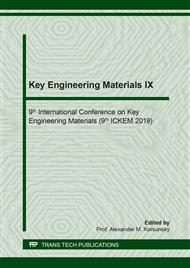[1]
L. A. Vilbois, A. Cheknane, A. Bensaoula, C. Boney, and T. Benouaz, Simulation of a solar cell based on InGaN, Energy Procedia 18 (2012) 795-806.
DOI: 10.1016/j.egypro.2012.05.095
Google Scholar
[2]
M. Moustafa, A. Paulheim, M. Mohamed, C. Janowitz, R. Manzke, Angle-resolved photoemission studies of the valence bands of ZrSxSe2− x, Appl. Surf. Sci. 366 (2018) 397-403.
DOI: 10.1016/j.apsusc.2016.01.024
Google Scholar
[3]
H. Xiao, X. Wang, J. Wang, N. Zhang, H. Liu, Y. Zeng, J. Li, and Z. Wang, Growth and characterization of InN on sapphire substrate by RF-MBE, J. Cryst. Growth 276 (2005) 401.
DOI: 10.1016/j.jcrysgro.2004.12.001
Google Scholar
[4]
H. Hamzaoui, A.S. Bouazzi, and B. Rezig, Theoretical possibilities of InxGa1−xN tandem PV structures, Sol. Energy Mater. Sol. Cells 87 (2005) 595-603.
DOI: 10.1016/j.solmat.2004.08.020
Google Scholar
[5]
X. Huang, Houqiang Fu, H. Chen, X. Zhang, Z. Lu, J. Montes, M. Iza, St. P. DenBaars, S. Nakamura, and Y. Zhao, Nonpolar and semipolar InGaN/GaN multiple-quantum-well solar cells with improved carrier collection efficiency, Appl. Phys. Lett. 110, (2017) 161105.
DOI: 10.1063/1.4980139
Google Scholar
[6]
Z. Keyan, W. Yadong, and C. Soo Jin, Low dimensional nanostructured InGaN multi-quantum wells by selective area heteroepitaxy, Phys. Status Solidi C, 6 S2S (2009) S514-S518.
DOI: 10.1002/pssc.200880777
Google Scholar
[7]
M. Burgelman, K. Decock, S. Khelifi and A. Abass, Advanced electrical simulation of thin film solar cells, Thin Solid Films 535 (2013) 296-301.
DOI: 10.1016/j.tsf.2012.10.032
Google Scholar
[8]
M. Moustafa and T. AlZoubi, Numerical study of CdTe solar cells with p-MoTe2 TMDC as an interfacial layer using SCAPS, Modern Physics Letters B 32, No. 23, (2018) 1850269.
DOI: 10.1142/s021798491850269x
Google Scholar
[9]
M. Moustafa and T. AlZoubi, Effect of the n-MoTe2 interfacial layer in cadmium telluride solar cells using SCAPS, Optik 120 (2018) 101-105.
DOI: 10.1016/j.ijleo.2018.05.112
Google Scholar
[10]
A. S. Barker, Jr. and M. Ilegems, Infrared Lattice Vibrations and Free-Electron Dispersion in GaN, Phys. Rev. B 7 (1973) 743.
DOI: 10.1103/physrevb.7.743
Google Scholar
[11]
Z. Z. Bandić, P. M. Bridger, E. C. Piquette, and T. C. McGill, Minority carrier diffusion length and lifetime in GaN, Appl. Phys. Lett. 72 (1998) 3166.
DOI: 10.1063/1.121581
Google Scholar
[12]
X. Huang, Houqiang Fu, H. Chen, X. Zhang, Z. Lu, J. Montes, M. Iza, St.P. DenBaars, S. Nakamura, and Y. Zhao, Nonpolar and semipolar InGaN/GaN multiple-quantum-well solar cells with improved carrier collection efficiency, Appl. Phys. Lett. 110 (2017) 161105.
DOI: 10.1063/1.4980139
Google Scholar
[13]
J.A. Van Vechten, T. K. Bergstresser, Electronic Structures of Semiconductor Alloys, Phys. Rev. B1 (1970) 3351.
DOI: 10.1103/physrevb.1.3351
Google Scholar
[14]
F. Bouzid and L. Hamlaoui, Investigation of InGaN/Si double junction tandem solar cells, J. Fundam Appl Sci. 4 (2012) 59-71.
DOI: 10.4314/jfas.v4i2.1
Google Scholar
[15]
A. Mesrane, F. Rahmoune, A. Mahrane, and A. Oulebsir, Design and Simulation of InGaN 𝑝-𝑛 Junction Solar Cell, Int. J. photoenergy 2015 (2015) 1-9.
DOI: 10.1155/2015/594858
Google Scholar
[16]
S. R. Kurtz, P. Faine, and J. M. Olson, Modeling of two-junction, series-connected tandem solar cells using top-cell thickness as an adjustable parameter, J. Appl. Phys. 68 (4) (1990) 1890-895.
DOI: 10.1063/1.347177
Google Scholar
[17]
Z. Li, H. Xiao, X. Wang, C. Wang, Q. Deng, L. Jing, J. Ding, X. Hou, Theoretical simulations of InGaN/Si mechanically stacked two-junction solar cell, Physica B 414 (2013) 110-114.
DOI: 10.1016/j.physb.2013.01.026
Google Scholar


